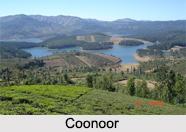 Udhagamandalam or Ooty is a beautiful place and there also beautiful places surrounding it. Elk Hills, Green Valley View, Snowden Peak and Doddabetta Peak are the most important viewpoints around Ooty. The chief among these places is the Doddabetta peak which is the highest and is at a height of 2623m. One can see as far as the plains of Coimbatore and the plateau of Mysore if the day is clear. Some other places around Ooty are given here:
Udhagamandalam or Ooty is a beautiful place and there also beautiful places surrounding it. Elk Hills, Green Valley View, Snowden Peak and Doddabetta Peak are the most important viewpoints around Ooty. The chief among these places is the Doddabetta peak which is the highest and is at a height of 2623m. One can see as far as the plains of Coimbatore and the plateau of Mysore if the day is clear. Some other places around Ooty are given here:
Coonoor
This is situated about 17 kms from Udhagamandalam. Coonoor is at an altitude of 2000 ft and is the first of these hill stations. Coonoor is a small town with a composed climate that has made it popular. The main attraction here is the Sim`s Park. This is a well-maintained hill station and contains several types of plants, which cannot be found in other hill stations.
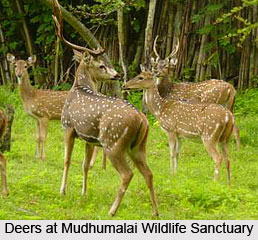 Some other important view points, picnic spots and places of tourist interest in Coonoor are the Lamb`s Rock, Lady Canning`s Seat, Dolphin`s Nose, St Catherine Falls, Law`s fall, Rallia Dam, The Droog, Pomological Station, Kalian Agricultural Farm, and Burliar Agricultural Farm.
Some other important view points, picnic spots and places of tourist interest in Coonoor are the Lamb`s Rock, Lady Canning`s Seat, Dolphin`s Nose, St Catherine Falls, Law`s fall, Rallia Dam, The Droog, Pomological Station, Kalian Agricultural Farm, and Burliar Agricultural Farm.
Mudhumalai Wildlife Sanctuary
This sanctuary is the most famous in the state and the most important in the southern region. The thick forest of Madhumalai contains Tiger, spotted deer, elephant, gaur, sambar, barking deer, wild boar, civet cat, flying squirrel, four-horned antelope, bison, mouse deer, common langur, bonnet macaque, pangolin, the scaled ant-eater, panther, leopard, hyena, sloth-bear and jackal.
The birds of this sanctuary are peacock, woodpeckers, several species of owls, vultures, buzzards and the grey jungle fowl. The millions of glow-worms which look like a dream world of illumined quiet lit up the whole sanctuary during the April nights.
Theppakadu is an elephant camp within the sanctuary. A rest-house is also here. Accommodation is also available in TTDC youth hostel and rest-houses in Masinagudi, Abhayaranyam, Kargudi and Bamboo Banks Farm. The best time to visit here is between January-March and September-October.
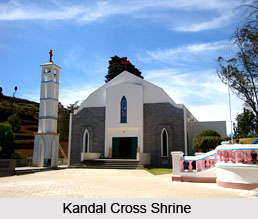 Ketti Valley Viewpoint
Ketti Valley Viewpoint
It is situated on the road to Coonoor. This peaceful place is a bunch of small villages that extend to the plains of Coimbatore and Mysore plateau.
Glenmorgan
Ecologically, this place is a rich forestry spot. It is situated about 17 kms from Udhagamandalam. The Electricity Board from here carries staff from Glenmorgan Viewpoint to power house at Singara. All the 4 km of the winch track passes through undisturbed sholas and wildlife habitats. The visitors can enter the viewpoint zone by taking prior permission of the E.B.
Upper Bhavani
It is situated about 10 kms from Korakundha and 20 kms from Avalanche. This place is regarded as a naturalists` paradise. This is also a rich and undisturbed wildlife habitat. From Bangithapal via Sirpura one can trek to Silent Valley. The permission of the forest department is must to go there.
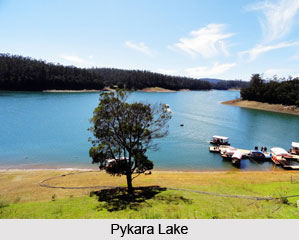 Kalhatty Falls
Kalhatty Falls
It is situated on the Kalhatty slopes, 13 kms from Udhagamandalam on the Mysore Kalhatty Ghat road. The height of the waterfalls is 100 ft. This slope is rich in wildlife such as panthers, bisons, wild buffaloes, wild dogs, spotted deer, sambars and different varieties of hill birds.
Cairn Hill
This hill is situated about 3 kms on the road to Avalanche. It is one of the few surviving original walks. The entrance road to the hill is bordered by dense cypress trees. It is also a good picnic spot. The chirping of birds in the shrubs breaks the silence of the cypress woods here, which is unforgettable experience for any visitor.
Kandal Cross Shrine
This is a Roman Catholic Church to the Nilgiris Catholics `The Calvary of Tamil Nadu`. It is situated about 3 kms from Ooty railway station on the western side. A relic of the true cross can be seen here. It cures the sick, bestows peace and joy to the visitors. Every Friday, special prayers and holy masses are offered. The annual feast falls on 3rd May each year.
Kamaraj Sagar (Sandynallah Reservoir)
This is a dam and is a nice picnic spot. One can reach there via Kandal amidst old trees and green shrubs of various terrains via the Hindustan Photo Films in Gudalur road. It is a good place to study nature and the environment and the fishing here is an excellent game in the dam.
The Mukurthi Peak and Mukurthi National Park
It is situated about 40 kms far from Ooty. It is located on the south-eastern corner of the Nilgiris. A large number of Nilgiri trees (Hamitragus hilverius) can be seen here. On the western side of these ranges, the `Silent Valley` is located.
The main feature of Mukurthi National Park is its variety and similarities to Himalayan flora and fauna.
Pykara
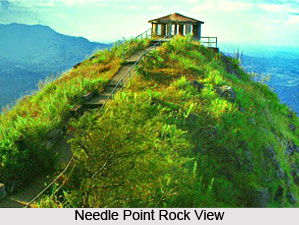 It is about 21 kms away on the Ooty-Mysore road. Pykara has a well protected fenced sholas, Toda settlements, undisturbed grassy meadows and wildlife habitat. A large number of tourists come here to see the Pykara dam, Pykara falls and Pykara reservoir here. There is a boat house and restaurant here maintained by T.T.D.C. One of the enthralling sights here is the pykara power station to which water is carried through pipelines along the slope.
It is about 21 kms away on the Ooty-Mysore road. Pykara has a well protected fenced sholas, Toda settlements, undisturbed grassy meadows and wildlife habitat. A large number of tourists come here to see the Pykara dam, Pykara falls and Pykara reservoir here. There is a boat house and restaurant here maintained by T.T.D.C. One of the enthralling sights here is the pykara power station to which water is carried through pipelines along the slope.
Avalanche
This beautiful lake is situated about 28 kms far from Ooty. It is crowded with a thick shoal, where even sunlight cannot penetrate. It has a wide variety of avifauna and a real paradise for nature lovers.
Western Catchment
It is situated 28 kms far from Ooty. It contains rolling grassy downs interspersed with moderate shoals occupying depressions and valleys.
Kotagiri
It is situated 31 kms from Ooty. It is located 6503 feet above sea level. The climate here is very healthy. One can enjoy a pleasure ride on roads bordered by green tea beds on either side.
Kodanadu Viewpoint
It is situated about 16 kms on the eastern edges of the Nilgiris. A panoramic view of tea estates can be seen on the either side and the river Moyar is wonderful. The panoramic view of Rangasamy peak and pillar can be enjoyed from a watch-tower here. Bus services are available for Kotagiri.
St. Catherine Waterfalls
A magnificent view of St. Catherine waterfalls can be seen from Dolphin`s Nose, Coonoor. It is about 250 feet high. The visitors take a diversion at Araveni on the Kotagiri-Mettupalayam road to reach the top of the hills.
Gudalur town
It is situated about 51 kms from Udhagamandalam. It is the gateway to Nilgiris from Kerala and Karnataka. Ooty, Coonoor and Kotagiri lie in the upper highland of Nilgiris while Gudalur lies in the lower highland. The Ooty-Calicut road and the Ooty-Mysore road meet at Gudalur town. Most of this area is a green carpet.
Frog Hill Viewpoint
It is located about 14 kms from Gudalur on the way to Udhagamandalam. One can see the huge frog shape of a hill view from here.
Needle Point Rock View
It is situated about 12 kms on the way to Ooty from Gudalur. One can enjoy panoramic views of Mudhumalai wildlife sanctuary and Gudalur town from here.
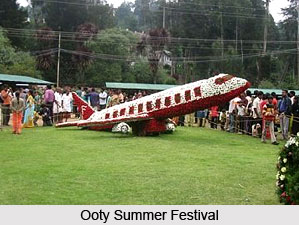
Numbal Kattah
This is a shrine of Battarayaswamy with sub-shrine built in Kerala style. Wynad scenes can be seen from here.
Nellialayam
The ruins of the historical Ummathur dynasty can be seen in this place.
Cherambadi
This place near Udhagamandalam is situated in the extreme western corner of the state. It has plantations and mica mines. Sultan Bathery is very near this place.
Hanging Bridges
It is situated on the way to Mudhumalai wildlife sanctuary. The places which attract the tourists here include a Siva temple at Baro Wood Valley, Marava Kandy Dam at Masinagudi and Moyar waterfalls.
Summer Festival
Udhagamandalam attracts lots of people during its Summer Festival and it is the best event during the season in May. Regular cultural programmes, fashion shows, flower and fruit shows, boat races, boat pageantry, dog shows etc. are held during the festival.



















